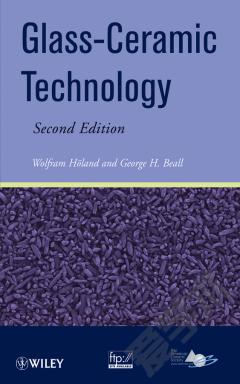Glass —— Mechanics and Technology
----- 玻璃
INTRODUCTION GLASS, A CERAMIC MATERIAL Four Classes of Materials Ashby's Charts Co-Selecting Materials Performance Indexes Shape Factors in Mechanical Design GLASS PRE- AND HISTORY Natural Glasses Early Glasses First Optical Glasses Modern Glasses APPLICATIONS OF GLASSES Glazing Packaging Optical Glass Glass Fibres for Insulation and Reinforcement Abrasive Tools Glass Manufacturers GLASS STRUCTURE Introduction Silica Glass and Related Glasses Organic and Chalcogenide Glasses Avoiding Crystallization Surface Structure GLASS RHEOLOGY Viscosity Glass Transition and its Observation How to 'Observe' Glass Transition? Viscous Response of Glass Visco-Elastic Response of Glass Tempering of Glass MECHANICAL STRENGHT OF GLASS Theoretical Strength Tensile Resistance of Glass Stress Concentration Linear Elasticity Crack Tip Stress Field Toughness Measurement Influence of Residual Stress on Strength and Fragmentation Statistic Weibull Analysis CONTACT RESISTANVCE OF GLASS Sharp and Blunt Contact Sharp Contact Resistance Abrasion Resistance Cutting of Glass Application to other Materials AGEING OF GLASS Stress Corrosion Charles and Hillig Theory Life Time Under Static Fatigue Applications MECHANICS OF GLASS PROCESSES Introduction Float Process Blow-and-Blow and Press-and-Blow Process Fusion Draw PRODUCTION AND CONTROL OF RESIDUAL STRESSES Introduction Residual Stresses in Flat Glass Basics of Photoelasticity in Flat Glass Stress Meters HIGH-TECH PRODUCERS AND R&D Market Trend Driven R&D Flat Display Panel Thin Film Technology Residual Stresses in Thin Film Applications Conclusion APPENDICES
{{comment.content}}








 京公网安备 11010802027623号
京公网安备 11010802027623号